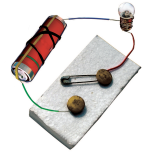6th Grade > Physics
ELECTRICITY AND CIRCUITS MCQs
:
A switch is a simple device that is used to either break the electric circuit or to complete it.
:
Conductivity: 1 Mark
Examples: 1 Mark
Metal conducts electricity because they have free electrons which act as charge carriers.
Some metals that are used in electric circuits are Aluminium, Copper etc. The metals are chosen because of their good conductivity.
:
Explanation: 2 Marks
The plastic or rubber that the handles are insulating materials which do not let electricity pass through it.
Without the help of insulators, the use of electrical tools like pliers and screwdrivers is impossible. Wood and plastics are insulators and help in avoiding direct contact with electric current. When electricians touch these live electric wires with the tools covered with plastic or rubber, the current does not electrocute them.
:
Electric cells are used in alarm clocks, wrist watches, transistor radios, cameras and many other devices.
:
Statement: 1 Mark
Explanation: 3 Marks
Lighting the bulb: 1 Mark
No, the bulb will not glow in this circuit because the switch is open and the circuit is incomplete.
Whenever the circuit is incomplete, no current flows through it.
So to light the bulb we can complete the circuit by putting any conductor connecting the two terminals.
So when the pin is moved in such a way that it touches both the terminals, the circuit is completed.
When the circuit is completed, the bulb starts glowing.
:
Definition: 1 Mark
Function: 1 Mark
Mechanism: 2 Marks
Examples: 1 Mark
A filament is a thin wire inside a bulb which is made of a resistive material.
It is responsible for the light being emitted from the bulb.
When electricity passes through the material then the filament gets heated because of its high resistivity.
When the filament is heated it releases some energy in the form of light.
Any material which has high resistivity and gets heated at a low temperature can be used as a filament.
Tungsten is currently used to make filaments of the bulbs.
:
Electric Circuit: 3 Marks
Components: 2 Marks
Electricity needs a path to flow from the positive terminal to the negative terminal of an electric cell. A connection that provides a path outside an electric cell, for the electricity to flow from the positive terminal to the negative terminal of the cell, is called electrical circuit. Various components together form an electric circuit. It is basically used to provide energy to various appliances such as mobile, microwave etc that we use in our day to day life.
Components of an electrical circuit are:-
1)Electric cell
2)Connecting wires
3)Bulb or electric device
4)Electric switch or key
:
Definition: 1 Mark
Elements: 1 Mark
Functioning: 1 Mark
An electric cell is a device that converts chemical energy into electrical energy.
It has two terminals which are made of metal - one terminal is positive, while the other one is negative.
When the two terminals are connected to an electrical device, electric current flows through it.
The positive terminal of an electric cell is the metal cap, and the metallic disc is the negative terminal.
An electric cell produces electricity from the chemical stored in it. When the chemical gets used up it stops working.
:
Definition: 1 Mark
Working: 1 Mark
Identification: 1 Mark
A conduction tester is a device with a bulb that can be used to determine whether an object is a good conductor or not.
The conduction tester is connected with the object in question, and electricity is made to pass through it. If the bulb starts glowing, it means that the electricity has managed to pass through the object, which means the object is a good conductor of electricity. If the bulb doesn't glow, the object is a bad conductor since it didn't let any electricity through.
So if the bulb started glowing when the object was connected to the conduction tester, it means that the object is a good conductor.
:
Definition: 1 Mark
Differences: 1 Mark each
Conductors: Those materials which conduct electricity and allow current to pass through them.
Insulators: Those materials which do not conduct electricity and do not allow current to pass through them.
1) A conductor allows electricity to pass through it, whereas insulator does not allow electricity to pass through it.
2) Conductors have free electrons, whereas insulators do not have free electrons.
3) When we touch a conductor which is connected to a live circuit, we will get electrocuted, whereas insulator protects us from the electric shock.

















